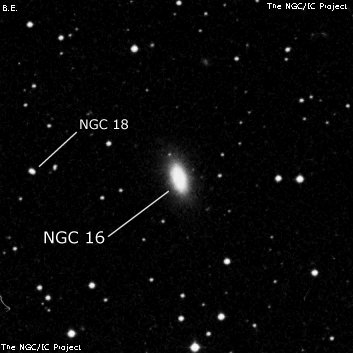
William Herschel probably discovered NGC 16 = H IV-15 = h4 = h5 on 8 Sep 1784. He recorded "Stellar, or rather like a faint star with a small chevelure and two burs [sic]. F, S." His RA is 1 min 24 seconds east (using a different star Corwin found an error of 1 min 6 seconds) of UGC 80. JH observed this object on 5 Sep 1828 and logged "pB; R; bM; 30" (? if not IV. 15)" Due to the difference in position he wasn't sure if his object was new, but listed it as a Nova. JH swept the area again 11 nights later and found h5, which he assumed was his father's IV-15: "a star 15m with a burr, RA from Cat.", though without an RA the identification of h5 is unknown. In the NGC, Dreyer equates h4 = h5 = H IV-15 = NGC 16 and Corwin favors this interpreation. Wolfgang Steinicke feels H IV-15 more likely applies to NGC 22 than NGC 16. His RA is off by 40 sec (too far east) and 7' too far south and the description "F, S, Stellar, or rather like a faint star with a small chevelure and two burs." may be a better fit.
J.L.E. Dreyer, using the 72" at Birr Castle on 29 Oct 1877, recorded "pB nucl with vF neby; round; E sp nf; 2 st 13 and 12 mag preceding in the parallel about 4' and 5' distant."
200/250mm - 8" (8/16/82): fairly faint, small, elongated N-S, bright nucleus at 200x.
8" (6/19/82): fairly faint, small, slightly elongated N-S, weak concentration.
300/350mm - 13.1" (8/24/84) : moderately bright, small, bright stellar nucleus, small fainter lens SSW-NNE.
400/500mm - 17.5" (11/14/87): moderately bright, fairly small, oval SSW-NNE, small bright core, stellar nucleus.
17.5" (9/19/87): fairly bright, moderately large, elongated ~N-S, bright core, stellar nucleus. NGC 22 lies 12' NE.
Notes by Steve Gottlieb